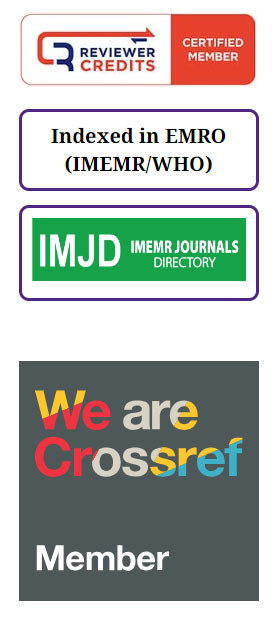AUTHORSHIP POLICY
Avicenna Journal of Medical Sciences (AJMS) follows the International Committee of Medical Journals Editor (ICMJE) guidelines for authorship criteria as “Defining the Role of Authors and Contributors” available at: http://www.icmje.org./recommendations/browse/roles-and-responsibilities/defining-the-role-of-authors-and-contributors.html
Each author must have made substantial contributions to the work to be considered an author, according to the principal author. One must fulfil all four of the following criteria for authorship, according to ICMJE rules.
- Idea or creation
- The gathering, examination, or interpretation of data
- Writing and approval of the manuscript
- Each author accepts responsibility for the entirety of the work, ensuring that any concerns about the veracity or integrity of any part of it are duly examined and addressed.
The mere arrangement of a research grant, the gathering of data, or general project management cannot justify authorship. Such actions could also be acknowledged in various ways. When submitting the work, the primary author must include the names of other authors in the proper order. Later additions of authors are not permitted. Contributions from authors will be published alongside the document. The editorial board will decide on any authorship disputes in accordance with ICMJE and COPE norms. The authors who assume primary responsibility for the manuscript should be identified when the study was carried out by a sizable, multi-center group. The above-described standards for authorship should be fully met by these. The corresponding author should explicitly identify all authors in a group author manuscript before submitting it. The acknowledgements section needs to list the other group members. After submission, changes to the authors' names or order are not permitted.
Authorship Disputes
Acknowledgements
This journal advocates acknowledging contributions to a scientific work where authorship is not claimed. All additional individuals who contributed to the study and are not a part of authorship should be credited, and their contributions should be detailed, according to ICMJE criteria. All authors must reserve the right to know their contributions were acknowledged along with the technical assistance, data gathering assistance, writing assistance and services offered from departmental head. Support in terms of funding and access to scientific instrumentation should also be acknowledged.
Number and order of authors
The number of authors is not limited, although it shouldn't be substantially higher than the amount of work produced. The contribution to the work should determine the rank of the authors. All authors should concur on the number and arrangement.
Principal and corresponding authors
Author with the most significant contribution should be ranked as the principal/first author. First author or the primary author should be the person who contributed the most. The principal author may, with the consent of all authors, either be the corresponding author himself or nominate another author for it.
Informed consent and competing interst
Before including case specifics, other personal information, or images of patients and other persons in their work, writers must first obtain the relevant authorization forms, permits, and releases in order to be in compliance with the country's or region's data protection and privacy laws.
- Each participant who appears in any video, audio, photograph, image, illustration, case report, or other form in which they can be identified, or who is the person's legal guardian, or another person with legal authority to act on their behalf, is informed beforehand that such photographs are being taken or such video, recording, photograph, image, illustration, or report is being made and of all the purposes for which they might be used, including disclosure. That person, their legal guardian, or another person in a position of authority must express their written consent in order for it to be accepted.
- The written consent must abide by all applicable privacy and data protection laws in its entirety. When minors are involved (especially those with special needs or learning difficulties), when an individual's head or face appears, or while the individual's name or other personal information is mentioned, extra caution should be given when acquiring consent.
- In the instance of a child, consent should be regarded not to have been provided and those photographs should not be disseminated if the child's parents or legal guardians disagree with the use of those images. To decrease the probability of images being used improperly, it is also crucial to make sure that only pictures of child wearing appropriate clothing are displayed.
- Even if permission has been granted, care must be taken to ensure that the person being depicted and captioned are courteous and cannot be seen as disparaging that person.
- In order to publish a manuscript, authors must persuade the editors that "informed consent to participate" was obtained from all adult subjects or from the parents or guardians of any minor subjects.
- Names, initials, hospital or social security numbers, dates of birth, or other personal or identifiable information should not be used for patients or research participants.
- Images of patients or research subjects should not be used for publication unless it is absolutely necessary for the scientific investigation and the patient (or parent/guardian) has given written, informed consent. Identifying information ought to be omitted if it is unnecessary, even when consent has been given. Editors may request to submit the written consent.
- In cases where there is any ambiguity regarding anonymity, informed consent is required.
- The authors must make sure that the editors do not misrepresent the scientific meaning while choosing the themes.
- For the use of completely anonymized images from which the individual cannot be identified, such as X-rays, ultrasound images, pathology slides, or laparoscopic images, formal consent is not necessary so long as the images are free of any identifying marks and are not accompanied by text that could place the individual at risk of being identified.
- It is typically insufficient to anonymize a photo simply by adding eye bars or obscuring the subject's face if authorization has not been obtained.
- The CARE case report writing guidelines should be followed by authors.






